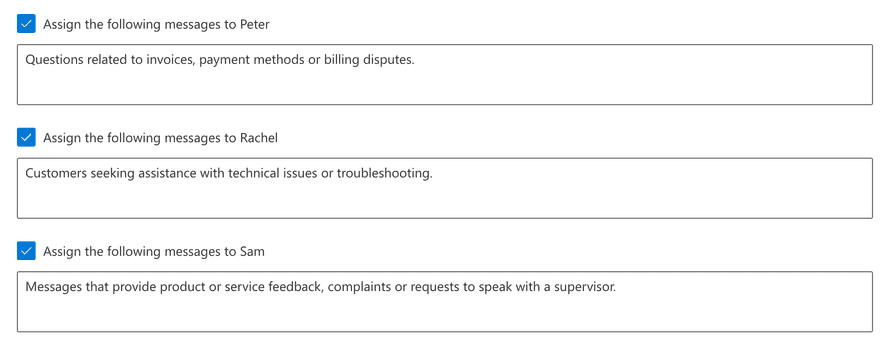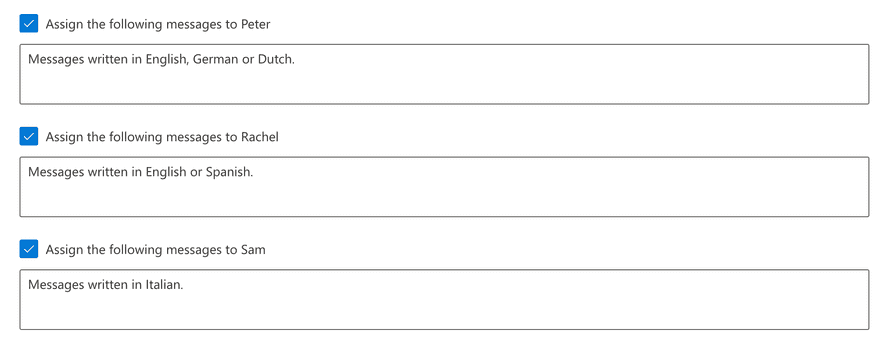- Productivity
How to use AI to route messages
In the fast-paced world of customer service, one of the most challenging tasks revolves around efficiently routing incoming inquiries to the appropriate team or team member. Discover how AI can drastically reduce resolution times by connecting customers with the right agents.
Customer service teams are swamped with all sorts of questions and issues, trying hard to figure out where each one should go. Manual routing processes are not only time-consuming but also prone to errors, leading to delays in response times and frustrated customers. Moreover, as organizations scale and diversify their product or service offerings, the complexity of routing inquiries increses exponentially. Without a streamlined solution in place, customer service teams face an uphill battle in ensuring prompt resolutions and delivering an exceptional customer service.
AI as game-changer
AI offers an opportunity to completely transform the automation of routing incoming messages to teams and individual team members with great precision and efficiency. Using its natural language processing (NLP) capabilities, AI can swiftly analyze the content, context and sentiment of incoming messages and route them to the most suitable team or team member based on a variaty of different factors.
This automation greatly reduces the need for manual intervention, streamlining the entire process and ensuring that inquiries are directed to the right destination promptly. Ultimately, AI-driven automation not only accelerates response times but also optimizes resource utilization.
Enter Yablo Genius
Yablo stands out as a customer communication platform designed specifically for Microsoft 365 users, offering invaluable assistance to customer-facing teams in managing their interactions more efficiently.
At the heart of Yablo lies its built-in AI assistant, Yablo Genius, adept at automating repetitive tasks. Among its many features, one standout capability is its proficiency in matching the intent of incoming messages with the skills assigned to team members. This ensures that messages are routed promptly and accurately to the most suitable team members, optimizing workflow and enhancing productivity.
Setting up AI-driven routing with Yablo Genius is incredibly simple. Unlike traditional systems that often depend on complex rule structures, Yablo Genius empowers you to articulate your objectives using natural language. This not only significantly reduces complexity but also unlocks possibilities for innovative scenarios that were previously unimaginable.
Take a look at the image below for a routing example in Yablo Genius. Pay attention to how each team member is described in terms of the types of messages that should be directed to them. Peter is responsible for questions related to invoices, payment methods and billing disputes, Rachel focuses on customers seeking assistance with technical issues, and Sam works on product & service feedback and complaints. No complex rules, all simply expressed in natural language.
You can draw parallels with traditional IVR menus encountered when calling a help desk: "Press 1 for invoicing questions, press 2 for technical support," and so forth. However, instead of mandating customers to make selections, AI now analyzes incoming requests and routes them accordingly.
Routing strategies
I would like to show you a few different kind of routing strategies that you can use to improve your routing process, and how you can easily implement them with Yablo and Yablo Genius.
Strategy 1: Topic-based routing
Using topic-based routing is highly effective, especially in complex environments where team members possess distinct areas of expertise. Tailoring the routing of incoming messages based on their nature ensures that each inquiry is directed to the team member whose skills align best with the request at hand.
The screenshot shown above demonstrates topic-based routing in action. Messages pertaining to invoices, payment methods, and billing disputes are directed to Peter, those requiring technical support are routed to Rachel, and inquiries regarding feedback and complaints are channeled to Sam.
Strategy 2: Priority-based routing
In your customer service team, you likely have both senior and junior staff members. To ensure top-notch customer experiences, you may opt to direct urgent cases to the senior team members, reserving less pressing matters for the junior staff to handle.
Instead of prioritizing routing based solely on urgency, a complementing approach is to consider the sentiment of the messages. For instance, connecting customers expressing frustration or anger with senior profiles can be beneficial, as these individuals typically possess more experience in handling such situations effectively.
In the example above, Peter, as the senior member, handles all urgent requests or messages from frustrated or angry customers. It's worth noting that we simply route all other messages to Rachel, our junior staff member.
Strategy 3: Language-based routing
In international settings, language barriers are a common obstacle. Historically, dealing with a single point of contact in a multi-language environment posed significant challenges. However, with the advent of AI, routing messages to team members proficient in the customer's language has become effortlessly achievable.
Setting up language-based routing is extremely simple. You just need to specify the languages each team member is fluent in and Yablo Genius will route incoming messages to match the languages of each member.
Strategy 4: Location-based routing
While this approach shares similarities with topic-based routing, I believe it warrants separate consideration. Let's consider a scenario: you operate a hotel group with properties in various countries or regions, yet you aim to provide customers with a unified point of contact across all locations.
What if AI could extract details such as the hotel or its location from incoming messages, enabling precise routing to the appropriate team responsible for that specific hotel or region?
Using the configuration displayed above ensures that Yablo Genius accurately routes inquiries related to specific hotels or regions (such as France or England) to the appropriate team member. This strategy vividly demonstrates the power of AI. For instance, if a query seeks information about a hotel near the Louvre, AI deduces its location in France and promptly directs the message to Peter.
Wrapping Up
AI-driven routing transforms customer service by automating message direction, and reducing response times. Solutions like Yablo Genius simplify complex scenarios, ensuring efficient and tailored support. Embracing AI is essential for staying competitive and delivering an exceptional service.
Choose a better way to manage your conversations
No credit card required. No commitments.









